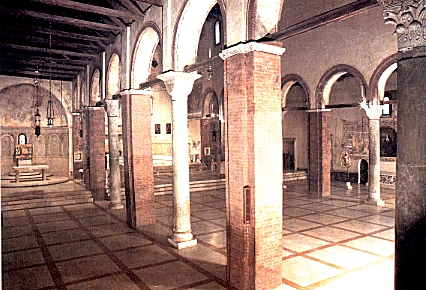The Cathedral - Nave Left

At this point it is better to start your visit to the aisles, starting from the left.
He returns at the bottom, towards the main door. High above I'ingresso I'organo and is located on the podium, external to it, there's Santo Stefano, a marble statue of the late seventeenth century, already sull'altrar more.
Then, on the left side: the second great fresco of the sixteenth century, an anonymous work, depicting St. Christopher as he crosses the river with the baby Jesus on his shoulders.
We are before a precious document of popular piety, because the saint was portrayed or outside churches or at the gate, usually towards the sea or river, in order to defend the waters I'abitato ruinous.
Here in Caorle from high tides and other dangers of the sea nearby.
The majestic image, since he had to be seen by everyone, was also to ensure the protection and defense against any kind of danger to those who, early in the morning, contemplating the figure of the saint.
Going into the aisle, has been observed in the wall the wooden statue of St. Rocco.
It comes from the demolished church of the saint who was on the outside, adjacent to the central apse, built after 1686, in ex-voto after the plague. Here are some paintings on the wall: Pentecost, anonymous work of the Venetian school of the mid-seventeenth century, the birth of the Virgin, by an anonymous seventeenth-century Venetian school, as a document of popular piety meant I'episodio on maternity protection, and here in Caorle in particular, for the success and protection of infants exposed to high mortality.
Tien behind the wall, the painting with S. Anthony of Padua by anonymous, of about 1671, a follower of Vicenza Maganza. I1 painting, besides the usual meaning of popular piety in relation to the famous saint, recalls the fraternity of the same name, and I'altare in his honor.
Then, nell'absidiola background, raised on the floor of the nave by three steps, deserve I'altare observation of the Most Holy, discreet contemporary work, and the tabernacle with the four Evangelists in gilded metal work kecente Legnaghi brothers.
To support the canteen, was used a Roman altar, the first century AD, belonging to the gens Licovia according I'ovvio epigraphic text: gens usually considered an inhabitant of the Roman Caorle, though lacking solid evidence. The altar stood in the altar preeslstente.
At the bottom of the apse, a few coats of one another in series.
The most valuable thing is given from the fresco in the apse, the recovery of recent restoration. At the center, seated on a throne in the shape of a simple tabernacle, is the Virgin and Child, while the sides there are the holy deacons, left and Stephen Lawrence, the patron saint of Caorle, right.
At their feet runs the procession of the members of the local school Beaten, kneeling in the hood and cap, with the guard on the left, leaning on his stick control.
The painting is valuable because it documents, in terms of illustrations, the presence of a local fraternity, erected in 1425, so I'affresco should be considered a little later. The author is unknown.
It has been hypothesized to be a follower of the Venetian Lorenzo. Perhaps it is better identified in the current of Giotto later Venetian, active in Eastern Veneto.
 More info - The cathedral outside
More info - The cathedral outside
 More info - The cathedral inside
More info - The cathedral inside
 More info - The cathedral nave right
More info - The cathedral nave right
 More info - The cathedral nave left
More info - The cathedral nave left
 More info - Cathedral the presbytery
More info - Cathedral the presbytery


